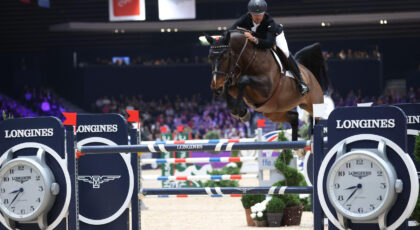It happens every winter. A horse that may not even have a prior history of laminitis is found to be very lame and reluctant to move. It’s more than the typical hesitation horses show on hard, frozen ground. Looks like laminitis but the feet aren’t hot. What’s going on?
Cold-induced hoof pain strikes horses with insulin resistance. IR is a well described risk factor for laminitis and even when the horse is not glaringly lame it is causing damage to the laminae. We haven’t uncovered all the mechanisms behind laminar damage from high insulin levels but one known factor is elevated levels of endothelin-1.
Endothelin-1 is a peptide (small protein) produced by the cells lining the interior of blood vessels. It is the most potent vasoconstrictor known and is normally balanced by production of the vasodilating chemical nitric oxide. Cold-induced reduction in blood supply to the hoof when superimposed on the pre-existing high endothelin-1 activity may explain why some IR horses develop hoof pain in cold weather but normal horses do not.

Cold stress may also cause insulin to rise. Insulin resistance is part of the metabolic adaptation to cold weather in several species. Researchers have also noted insulin levels become erratic in horses in cooler weather.
Laminitis caused by high insulin is different from laminitis due to other causes. Activation of enzymes and inflammatory reactions are not part of the picture. This probably explains why the usual treatment with NSAIDs [nonsteroidal antiinflammatory drugs] like phenylbutazone has little effect. There is help though.
Blanketing the horse when temperatures dip below the equine thermoneutral temperature of 45 F helps avoid cold stress. Keeping the lower legs wrapped and feet protected inside lined boots also helps maintain normal circulation to the distal extremities.
Adaptogens are herbs which support a healthy response to stressors like cold weather. Jiaogulan [Gynostemma pentaphyllum] is a particularly good choice because this herb is also known to support production of the vasodilator, nitric oxide. Jiaogulan should be given twice daily, preferably before a meal. Most horses love the taste and will lick it up as a powder or paste.
L-arginine is the amino acid precursor for nitric oxide and can be supplemented along with the Jiaogulan. L-citrulline is another amino acid that the body converts to L-arginine for nitric oxide production. Cold stress also results in considerable oxidative stress and antioxidants help neutralize these free radicals.
Finally, acetyl-l-carnitine supplementation can be indicated for support of normal nerve function and glucose handling.
When you understand the trigger of winter laminitis you can support the horse with simple measures to minimize cold stress and maintain normal blood flow to the feet.
*All content is for informational purposes only. Contact your veterinarian if you have any questions or concerns about the health of your animals.
About the Author
Dr. Eleanor Kellon is a renowned expert on equine nutrition and related health issues. She offers private nutritional consultations and online courses through Equine Nutritional Solutions. Find out more at www.drkellon.com, and read more of her articles at DrKhorsesense.com.




 December 27, 2017
December 27, 2017 




























